How to Wir GFCI Outlet with Multiple Outlets (Guide)
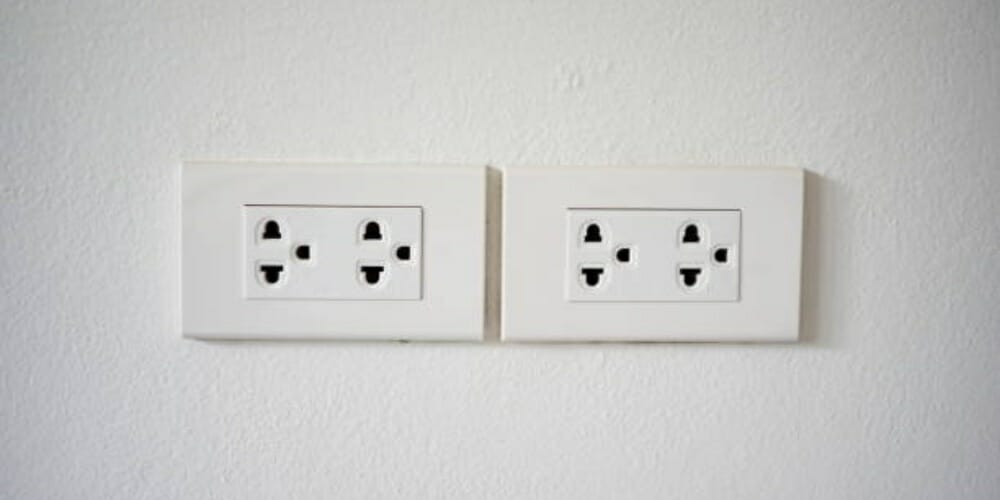
Wiring a GFCI outlet with multiple outlets might sound like a task that is only for the pros, but guess what?
It’s doable, and I’m here to guide you through it. Whether you’re renovating your kitchen or just adding some safety to your bathroom, this is a project you’ll want to know how to tackle.
Quick Summary to wire a GFCCI outlet with multiple outlets:
- Multiple outlets can be connected to a GFCI outlet in a parallel arrangement.
- The line terminals of the additional outlets are connected to the load terminals of the primary outlet.
- The line terminals of the main source GFCI outlet are connected to the main electricity supply.
- All black wires should be connected to live (known as hot) terminals.
- All white wires should be connected to neutral terminals.
- All green or bare wires should be connected to ground terminals.
We’ll dive into the nuts and bolts of wiring up that GFCI outlet with others, ensuring your home is safer and more functional. Trust me, by the end of this, you’ll be ready to roll up your sleeves and get to work. So, let’s make your home safer together, shall we?
Understanding GFCI Outlets and Their Importance in Household Safety
Regarding household safety, one of the unsung heroes has got to be the Ground Fault Circuit Interrupter or GFCI outlet. You might be thinking, “What’s so special about an outlet?”
A GFCI outlet protects against electrical shock by monitoring the electricity flowing in a circuit. If it detects any imbalance, like electricity flowing through an unintended path, it shuts down the power in a fraction of a second—fast enough to prevent a harmful electric shock.
Why is this important, you ask? Electricity is a powerful and essential part of our lives but can also be incredibly dangerous. Regular outlets can’t detect hazardous ground faults, which can lead to severe injuries or even fatalities.
That’s where GFCI outlets come in, acting as a critical line of defense in areas prone to moisture—like bathrooms, kitchens, and outdoor spaces. These areas are particularly risky because water conducts electricity, increasing the chance of accidental shocks.
But it’s not just about preventing shocks. GFCI outlets also help to protect your electrical system from damage. Quickly cutting off the power prevents overheating and reduces the fire risk caused by faulty wiring or appliances.
Installing GFCI outlets is a proactive step towards safeguarding your household. It’s about peace of mind, knowing that you’re taking a significant precaution against potential electrical hazards.
Remember, electricity doesn’t give second chances, so it’s crucial to prioritize safety in every aspect of your home’s electrical system.
Parts of a GFCI Outlet
Before wiring a GFCI with multiple outlets, it’s essential to familiarize yourself with the different parts and terminals of a GFCI outlet. This knowledge is crucial for a successful and safe installation.
A GFCI outlet includes two pairs of terminals labeled LINE and LOAD. These labels are critical in ensuring that the wiring is done correctly.
The LINE terminals connect to the incoming power source, while the LOAD terminals connect additional outlets downstream in the circuit that you want to protect with the GFCI.
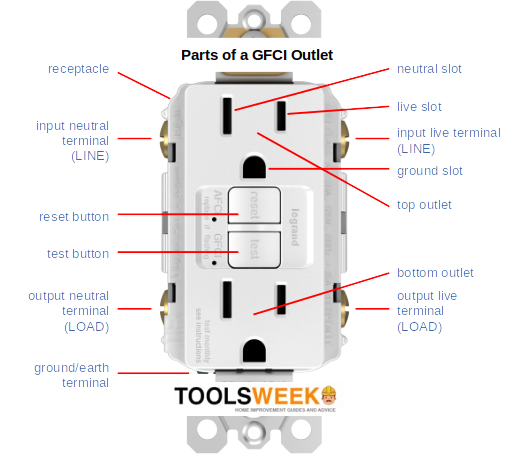
It’s also important to understand the terminology used for the wires. The live wire, which carries the current into the outlet, is known as the ‘hot’ or ‘line’ wire.
This wire is typically black or red. The neutral wire, which carries the current back after it passes through your appliances, is usually white or gray.
Then there’s the ground wire, which provides a safe path for electricity in case of a fault. This wire can be green with yellow stripes or bare copper.
When it comes to the terminals on the GFCI outlet, they might have different types of screws. Generally, the live terminals are marked with bronze screws, the neutral terminals with silver screws, and the ground terminal with a green screw.
These color-coded screws help ensure that each wire is connected to the correct terminal, which is vital for the GFCI outlet to function properly and provide the necessary protection against electrical shocks.
Understanding these components and their functions is the first step in safely and effectively wiring a GFCI outlet with multiple outlets. Knowing where each wire goes and ensuring that connections are made correctly can prevent electrical hazards and ensure the safety of your home’s electrical system.
Connecting Multiple Outlets
When it comes to making your home safer from electrical hazards, a GFCI outlet is a great tool.
It’s designed with a built-in circuit breaker that immediately shuts off the power if it detects a current surge, leakage, or ground fault. This is key for protecting against electric shocks.
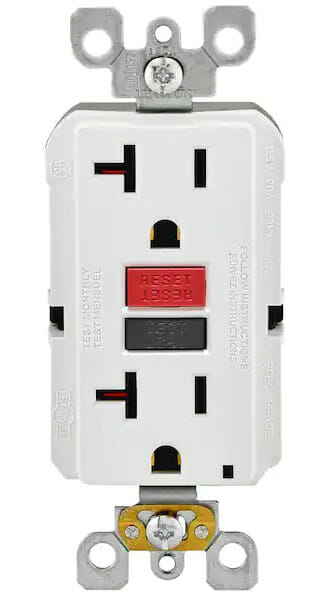
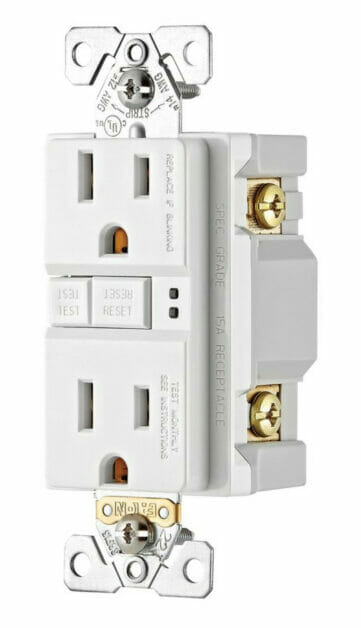
One of the fantastic features of a GFCI outlet is the ability to connect it to multiple other standard outlets. This way, all connected outlets get the same protection against electrical shocks.
Many homeowners choose this cost-effective method. For instance, in a garage setup, as required by the National Electrical Code (NEC) 211.10, connecting additional outlets to a GFCI outlet ensures that all are safeguarded.
By wiring multiple outlets to a single GFCI, if there’s a current leak or surge in any outlets, the GFCI outlet will cut off power to all of them. This is how it provides a broad level of protection.
However, while this approach is beneficial, it comes with a caveat. If a problem arises, it might not be immediately clear which outlet is the cause.
Unlike a setup where each outlet has its own GFCI protection and the source of a trip is obvious, using one GFCI for multiple outlets means you’ll need to check each connected outlet to pinpoint the problem.
It’s particularly important to have GFCI protection in areas of your home prone to wetness or moisture. This includes kitchens, bathrooms, laundry rooms, basements, wet bars, outdoor areas like spas and swimming pools, or any place near plumbing.
Protecting these areas with GFCI outlets, individually or in a series, is essential for your safety and compliance with safety standards.
Wiring for Single and Multiple Locations
Wiring a GFCI outlet can be done in two main ways: to protect just the outlet itself, which is known as a single location, or to protect multiple outlets, switches, and fixtures, which are referred to as multiple locations.
The pictures below illustrate the difference between the two setups.
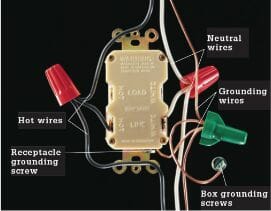
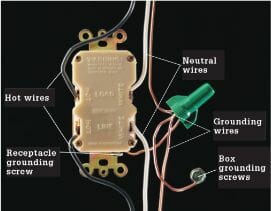
The setup is pretty straightforward when wiring a GFCI for just a single location. The hot wire, usually black or red, and the neutral wire, typically white or gray, are connected to the LINE terminals on the GFCI outlet. This common method is used in many homes because it protects just the outlet.
On the other hand, if the goal is to wire the GFCI outlet to protect multiple locations, the wiring needs more attention. In this setup, one pair of hot and neutral wires is connected to the LINE terminals, just like in the single-location setup.
However, another pair of wires is connected to the LOAD terminals. These LOAD terminals might be hidden under a yellow sticker, especially if the GFCI outlet is new.
The ground wires, which can be green, green with yellow stripes, or bare copper, are twisted together in a pigtail configuration and connected to the outlet’s green ground terminal.
This setup allows the GFCI to extend protection to other outlets or fixtures downstream in the same electrical circuit. If there are additional outlets you want to be protected, this wiring pattern is replicated for each.
Choosing between wiring for a single location or multiple locations depends on your needs. However, it’s worth noting that GFCI outlets are more effective and have fewer issues when wired to protect just a single location.
This is because GFCI outlets are very sensitive to fluctuations in electrical current. Wiring them to protect a single location can help minimize unintended or ‘phantom’ tripping, which occurs when the GFCI shuts off power due to very small discrepancies in current that aren’t dangerous but are still detected by its sensitive circuitry.
This makes the single-location configuration a preferable choice for many, ensuring protection where it’s most needed without the inconvenience of unnecessary trips.
Wiring Multiple Outlets to a Single GFCI Outlet
If you’ve decided that wiring multiple outlets to a single GFCI outlet is the right choice for your project, or if it’s something you need to do, let’s dive into how to set it up.
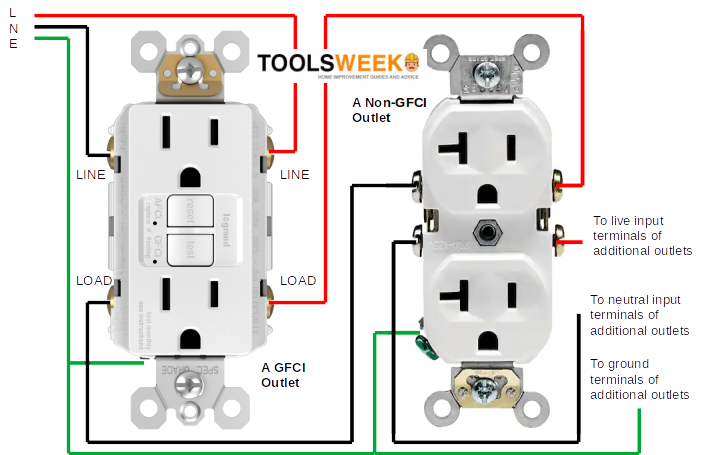
If you look at a wiring diagram for connecting multiple outlets to a single GFCI outlet, you’ll notice that the configuration is straightforward.
On the GFCI outlet, two pairs of terminals are on each side, categorized as LINE and LOAD buses. Each of these buses has a pair of terminals. When connecting additional outlets, you’ll be wiring them parallel to these terminals.
The LINE bus is where you make the input or supply connections. This means the live (hot) and neutral wires from your main electrical supply connect to the LINE terminals on the GFCI outlet. This is your starting point.
You connect the additional outlets you want to protect with the GFCI to the LOAD terminals of the GFCI outlet. Essentially, the LOAD terminals on the GFCI outlet serve as the source for the LINE terminals on the additional outlets. This is how you extend GFCI protection to those outlets.
Regarding the ground connections, all the outlets’ ground terminals should be connected and then to the main ground connection in your home. This ensures that the grounding protection is consistent across all outlets involved in this setup.
This method allows you to provide GFCI protection to multiple outlets by using just one GFCI outlet, making it a cost-effective and efficient way to enhance safety in areas of your home that might be exposed to moisture or require additional protection.
Electrical Protection Methods: GFCI, AFCI, and Circuit Breakers
Diving into the world of electrical safety, let’s explore the key players: GFCI outlets, AFCI outlets, and traditional circuit breakers.
Each offers unique protection for your home, safeguarding against potential hazards. Understanding their roles and when to use them can significantly enhance your home’s safety.
GFCI Outlets: The Lifeguards
- What They Do: GFCI outlets monitor the balance of electrical current and cut off power when they detect an imbalance, preventing electric shock. It is ideal for areas where electricity and moisture might meet.
- Where to Use Them: Bathrooms, kitchens, garages, and outdoor areas are prime spots for GFCI protection.
AFCI Outlets: The Detectives
- What They Do: AFCI outlets prevent fires by detecting dangerous electrical arcs, which are unintended electrical discharges that can ignite flammable materials.
- Where to Use Them: AFCI protection is beneficial in living rooms, bedrooms, and any areas prone to electrical fires.
Circuit Breakers: The Bouncers
- What They Do: Circuit breakers protect against circuit overloads and short circuits. They act as the main defense in your electrical panel, cutting power to circuits when the current exceeds safe levels.
- Where to Use Them: Circuit breakers are the fundamental protective layer for the home’s electrical system.
Combining Forces for Comprehensive Protection
Modern homes often use a combination of these technologies to ensure full protection.
GFCI and AFCI circuit breakers in the electrical panel can provide widespread protection without needing individual outlets, making your safety strategy effective and efficient.
Whether updating an older home or designing a new one, incorporating the right mix of these protective devices is crucial for preventing electric shocks and fires. Always prioritize safety and consult a professional electrician to ensure your electrical system meets all local codes and standards.
Troubleshooting Guide for Wiring GFCI Outlets with Multiple Outlets
Let’s dive into some troubleshooting! Imagine you’ve just wired up a GFCI outlet to multiple outlets in your home, and you’re standing back, admiring your handiwork.
But then, the unexpected happens. Maybe your GFCI outlet keeps tripping, or one of those downstream outlets isn’t powering up. Don’t worry; I’ve been there and am here to walk you through getting everything back on track.
| Challenge | Signs & Symptoms | Optimized Solutions |
|---|---|---|
| Persistent GFCI Tripping | Frequent, unexpected tripping. | – Minimize circuit load by unplugging devices. – Eliminate moisture around the outlet. – Identify and replace malfunctioning appliances. – Secure any loose wiring connections. |
| Non-Functional Downstream Outlets | There is no power in outlets beyond the GFCI. | – Confirm secure wiring at both GFCI and downstream outlets. – Perform a GFCI reset. – Diagnose and rectify faults in downstream outlets. |
| Fluctuating Power Supply | Unpredictable power disruptions. | – Tighten all electrical connections. – Evaluate circuit load and redistribute if overloaded. – Engage a professional for intricate diagnostics. |
| GFCI Outlet Refuses to Reset | Reset does not restore power. | – Unplug all devices and attempt reset. – Investigate for persistent wiring issues or ground faults. – Consider GFCI replacement if it remains non-responsive. |
| Unexplained GFCI Activation | Tripping without an apparent cause. | – Inspect the integrity of wiring and connections. – Check for external damage to outlets or wires. – Ensure the electrical supply is within the proper voltage range. |
| Power Absence Despite Reset GFCI | GFCI seems operational; downstream does not. | – Validate GFCI’s wiring and functionality. – Examine the circuit breaker for any trips. – Investigate internal issues within downstream outlets. |
| Appliance Use Causes GFCI Trips | Trips when specific devices are used. | – Test appliances individually to pinpoint problematic ones. – Ensure appliance wattage is within the circuit’s capacity. |
Always ensure the main power supply is turned off before embarking on any electrical troubleshooting or fixes. Utilize a non-contact voltage tester to verify the power-off status.
Important Safety Reminder: Before attempting any troubleshooting or electrical work, always switch off the main power to prevent electric shock.
Frequently Asked Questions
- How Do I Know If My GFCI Outlet Is Working Properly?
- You can test a GFCI outlet by pressing the “Test” button on the outlet, which should immediately shut off the power to the outlet and any connected downstream outlets. Pressing the “Reset” button should restore power. If this function does not work as described, the GFCI outlet may need to be replaced.
- What Should I Do If My GFCI Outlet Keeps Tripping?
- If your GFCI outlet keeps tripping, it may be due to a ground fault in your circuit, an overloaded circuit, or a defective appliance. Check for and address any moisture issues, unplug appliances, reset the GFCI, and check for wiring issues. If the problem persists, consult a professional electrician.
- Is It Necessary To Use GFCI Protection In The Kitchen And Bathroom?
- Yes, it is necessary and often required by code to use GFCI protection in the kitchen, bathroom, and other areas where electricity and water are likely to come into contact. GFCI outlets significantly reduce the risk of electric shock in these areas.
- Can I Install A GFCI Outlet Myself?
- If you are comfortable with basic electrical work and follow safety guidelines, install a GFCI outlet yourself. However, if you are unsure or uncomfortable with electrical work, it is recommended that you hire a professional electrician.
- What Tools Do I Need To Install A GFCI Outlet?
- To install a GFCI outlet, you will need a screwdriver, wire strippers, a voltage tester, and possibly needle-nose pliers. Ensure you have the correct type of GFCI outlet for your installation location and electrical requirements.
Resources
Organizations
- National Fire Protection Association (NFPA) – https://www.nfpa.org/
- Underwriters Laboratories (UL) – https://www.ul.com/
Books
- The Complete Guide to Wiring: Upgrade Your Main Service Panel – Discover the Latest Wiring Products by Black & Decker – https://books.google.com/books?id=QtVhK6z7mpQC&printsec=copyright
Websites
- Eaton (GFCI outlet – side view) – https://www.eaton.com/us/en-us/skuPage.SGF15W.html.
